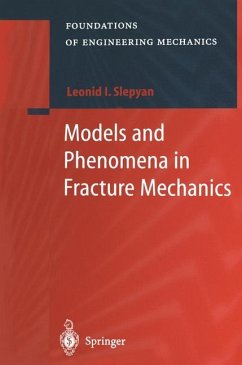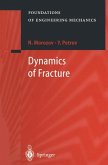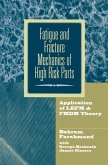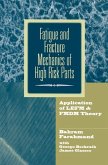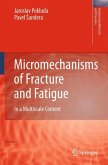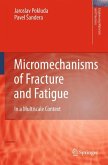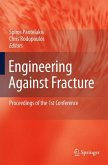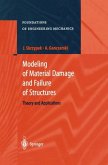Leonid I. Slepyan
Models and Phenomena in Fracture Mechanics
Leonid I. Slepyan
Models and Phenomena in Fracture Mechanics
- Broschiertes Buch
- Merkliste
- Auf die Merkliste
- Bewerten Bewerten
- Teilen
- Produkt teilen
- Produkterinnerung
- Produkterinnerung
Modern concepts of fracture mechanics are presented consecutively. Homogeneous and structured models, where microstructure plays an essential role, are considered for fracture and phase transition. Firstly, one-dimensional models are comprehensively studied allowing one to retrace the main phenomena without technical difficulties. More realistic models are then used as linear and nonlinear elastic mediums, such as elastic plates with crack closure, viscoelastic discrete lattices, chains and cohesive zone models. Also considered are, crack origination, equilibrium, slow and fast growth. Sub-…mehr
Andere Kunden interessierten sich auch für
![Dynamics of Fracture Dynamics of Fracture]() N. MorozovDynamics of Fracture75,99 €
N. MorozovDynamics of Fracture75,99 €![Fatigue and Fracture Mechanics of High Risk Parts Fatigue and Fracture Mechanics of High Risk Parts]() Bahram FarahmandFatigue and Fracture Mechanics of High Risk Parts112,99 €
Bahram FarahmandFatigue and Fracture Mechanics of High Risk Parts112,99 €![Fatigue and Fracture Mechanics of High Risk Parts Fatigue and Fracture Mechanics of High Risk Parts]() Bahram FarahmandFatigue and Fracture Mechanics of High Risk Parts115,99 €
Bahram FarahmandFatigue and Fracture Mechanics of High Risk Parts115,99 €![Micromechanisms of Fracture and Fatigue Micromechanisms of Fracture and Fatigue]() Jaroslav PokludaMicromechanisms of Fracture and Fatigue149,99 €
Jaroslav PokludaMicromechanisms of Fracture and Fatigue149,99 €![Micromechanisms of Fracture and Fatigue Micromechanisms of Fracture and Fatigue]() Jaroslav PokludaMicromechanisms of Fracture and Fatigue149,99 €
Jaroslav PokludaMicromechanisms of Fracture and Fatigue149,99 €![Engineering Against Fracture Engineering Against Fracture]() Engineering Against Fracture112,99 €
Engineering Against Fracture112,99 €![Modeling of Material Damage and Failure of Structures Modeling of Material Damage and Failure of Structures]() Jacek J. SkrzypekModeling of Material Damage and Failure of Structures112,99 €
Jacek J. SkrzypekModeling of Material Damage and Failure of Structures112,99 €-
-
-
Modern concepts of fracture mechanics are presented consecutively. Homogeneous and structured models, where microstructure plays an essential role, are considered for fracture and phase transition. Firstly, one-dimensional models are comprehensively studied allowing one to retrace the main phenomena without technical difficulties. More realistic models are then used as linear and nonlinear elastic mediums, such as elastic plates with crack closure, viscoelastic discrete lattices, chains and cohesive zone models. Also considered are, crack origination, equilibrium, slow and fast growth. Sub- and super critical crack speed regimes and transition from one regime to another are studied. Fourier transform and related topics, including a version of the Wiener-Hopf technique dealing with originals are presented, as well as required topics from wave theory. This book is targeted at researchers of materials and structures, also at lecturers and advanced students.
Produktdetails
- Produktdetails
- Foundations of Engineering Mechanics
- Verlag: Springer / Springer Berlin Heidelberg / Springer, Berlin
- Artikelnr. des Verlages: 978-3-642-07845-3
- Softcover reprint of hardcover 1st edition 2002
- Seitenzahl: 600
- Erscheinungstermin: 8. Dezember 2010
- Englisch
- Abmessung: 235mm x 155mm x 33mm
- Gewicht: 897g
- ISBN-13: 9783642078453
- ISBN-10: 3642078451
- Artikelnr.: 32072003
- Herstellerkennzeichnung
- Springer-Verlag GmbH
- Tiergartenstr. 17
- 69121 Heidelberg
- ProductSafety@springernature.com
- Foundations of Engineering Mechanics
- Verlag: Springer / Springer Berlin Heidelberg / Springer, Berlin
- Artikelnr. des Verlages: 978-3-642-07845-3
- Softcover reprint of hardcover 1st edition 2002
- Seitenzahl: 600
- Erscheinungstermin: 8. Dezember 2010
- Englisch
- Abmessung: 235mm x 155mm x 33mm
- Gewicht: 897g
- ISBN-13: 9783642078453
- ISBN-10: 3642078451
- Artikelnr.: 32072003
- Herstellerkennzeichnung
- Springer-Verlag GmbH
- Tiergartenstr. 17
- 69121 Heidelberg
- ProductSafety@springernature.com
1 Fundamentals and Basic Relations.- 1.1 Energy Release and Energy Criterion.- 1.2 Some Methods for Determination of Energy Release.- 1.3 Other Examples of the Energy Release Phenomenon.- 1.4 Stress Intensity Criterion.- 1.5 Some Fracture-Associated Phenomena.- 2 Fourier Transform and Related Topics.- 2.1 Continuous Fourier Transform.- 2.2 Wiener-Hopf Technique.- 2.3 Laplace and Fourier Transform.- 2.4 Discrete Fourier Transform.- 3 Waves.- 3.1 Waves of Sinusoidal and Exponential Types.- 3.2 Waves in Periodic Structures.- 3.3 Forced Waves.- 3.4 Waves in Homogeneous Space and Half-Space.- 3.5 Nonlinear Waves in a String.- 4 One-dimensional Models.- 4.1 String Model.- 4.2 Bending Beam Model.- 5 Static Cracks in a Linearly Elastic Body.- 5.1 Field Representations.- 5.2 Kolosov-Muskhelishvili Representation.- 5.3 Papkovich Representation.- 5.4 Crack in an Unbounded Plane.- 5.5 Asymptotes.- 5.6 Homogeneous Solutions.- 5.7 Integral Equations for a General Crack System.- 5.8 Crack Interaction.- 5.9 Energy Release Under Crack Kink.- 5.10 Cohesive Zone Model.- 5.11 Penny-Shaped Crack.- 5.12 Betti#x2019;s Theorem and the Weight Functions.- 6 Nonlinear Elastic Body.- 6.1 Some Data from Nonlinear Elasticity.- 6.2 Lagrangian and Eulerian Interpretation of Linear Elasticity.- 6.3 Strains in the Neighborhood of a Singular Point.- 6.4 Exact Relationships for the Energy Release and Some Consequences.- 7 Viscoelastic Fracture.- 7.1 Some Data from Viscoelasticity.- 7.2 Stationary Crack and Collinear Crack System.- 7.3 Growing Crack.- 7.4 Cohesive Zone for Viscoelastic Material.- 8 Elastic-Plastic Fracture.- 8.1 Elastic-Plastic Fields.- 8.2 Fixed Cracks.- 8.3 Growing Cracks.- 8.4 Elastic-Plastic Dynamic Fracture.- 9 Dynamic Fracture in a Homogeneous Elastic Medium.- 9.1 Some BasicRelations.- 9.2 Crack Tip Asymptotes and the Energy Release.- 9.3 Factorization of the Fundamental Solutions.- 9.4 Uniform Crack Propagation.- 9.5 Nonuniform Crack Speed Problem.- 9.6 Self-Similar Dynamic Problems.- 9.7 Dynamic Crack in a Plate Under Bending.- 9.8 Principle of Maximum Energy Dissipation Rate.- 10 Cracks in a Bending Plate.- 10.1 Asymptotic Solution for a Single Crack.- 10.2 Radial Cracking with Closure.- 10.3 Self-Similar Dynamic Problem.- 11 The Square-Cell Lattice.- 11.1 Preliminaries.- 11.2 Some Introductory Remarks.- 11.3 Elastic Lattice: Formulation and the Governing Equation.- 11.4 Factorization.- 11.5 Solutions.- 11.6 Viscoelastic Lattice.- 12 Triangular-Cell Elastic Lattice.- 12.1 Introductory Remarks.- 12.2 General Properties of Fundamental Solutions.- 12.3 Equations and General Solutions.- 12.4 Macrolevel-Associated Solution.- 12.5 Microlevel Solutions.- 12.6 Concluding Remarks.- 13 Phase Transition Waves.- 13.1 Introductory Remarks.- 13.2 Macrolevel Solution.- 13.3 Discrete Chain.- 13.4 Higher-Order-Derivative Model.- 13.5 Concluding Remarks.- 14 Dynamic Amplification Factor in Fracture and Phase Transition.- 14.1 Introductory Remarks.- 14.2 Line of Viscoelastic Oscillators.- 14.3 DOR and SAR Domains for Viscoelastic Oscillator.- 14.4 Viscoelastic Square-Cell Lattice.- 14.5 Slow Phase Transition Wave in a Chain.- 14.6 Triangular-Cell Lattice Irregularities in Fracture.- References.
1 Fundamentals and Basic Relations.- 1.1 Energy Release and Energy Criterion.- 1.2 Some Methods for Determination of Energy Release.- 1.3 Other Examples of the Energy Release Phenomenon.- 1.4 Stress Intensity Criterion.- 1.5 Some Fracture-Associated Phenomena.- 2 Fourier Transform and Related Topics.- 2.1 Continuous Fourier Transform.- 2.2 Wiener-Hopf Technique.- 2.3 Laplace and Fourier Transform.- 2.4 Discrete Fourier Transform.- 3 Waves.- 3.1 Waves of Sinusoidal and Exponential Types.- 3.2 Waves in Periodic Structures.- 3.3 Forced Waves.- 3.4 Waves in Homogeneous Space and Half-Space.- 3.5 Nonlinear Waves in a String.- 4 One-dimensional Models.- 4.1 String Model.- 4.2 Bending Beam Model.- 5 Static Cracks in a Linearly Elastic Body.- 5.1 Field Representations.- 5.2 Kolosov-Muskhelishvili Representation.- 5.3 Papkovich Representation.- 5.4 Crack in an Unbounded Plane.- 5.5 Asymptotes.- 5.6 Homogeneous Solutions.- 5.7 Integral Equations for a General Crack System.- 5.8 Crack Interaction.- 5.9 Energy Release Under Crack Kink.- 5.10 Cohesive Zone Model.- 5.11 Penny-Shaped Crack.- 5.12 Betti#x2019;s Theorem and the Weight Functions.- 6 Nonlinear Elastic Body.- 6.1 Some Data from Nonlinear Elasticity.- 6.2 Lagrangian and Eulerian Interpretation of Linear Elasticity.- 6.3 Strains in the Neighborhood of a Singular Point.- 6.4 Exact Relationships for the Energy Release and Some Consequences.- 7 Viscoelastic Fracture.- 7.1 Some Data from Viscoelasticity.- 7.2 Stationary Crack and Collinear Crack System.- 7.3 Growing Crack.- 7.4 Cohesive Zone for Viscoelastic Material.- 8 Elastic-Plastic Fracture.- 8.1 Elastic-Plastic Fields.- 8.2 Fixed Cracks.- 8.3 Growing Cracks.- 8.4 Elastic-Plastic Dynamic Fracture.- 9 Dynamic Fracture in a Homogeneous Elastic Medium.- 9.1 Some BasicRelations.- 9.2 Crack Tip Asymptotes and the Energy Release.- 9.3 Factorization of the Fundamental Solutions.- 9.4 Uniform Crack Propagation.- 9.5 Nonuniform Crack Speed Problem.- 9.6 Self-Similar Dynamic Problems.- 9.7 Dynamic Crack in a Plate Under Bending.- 9.8 Principle of Maximum Energy Dissipation Rate.- 10 Cracks in a Bending Plate.- 10.1 Asymptotic Solution for a Single Crack.- 10.2 Radial Cracking with Closure.- 10.3 Self-Similar Dynamic Problem.- 11 The Square-Cell Lattice.- 11.1 Preliminaries.- 11.2 Some Introductory Remarks.- 11.3 Elastic Lattice: Formulation and the Governing Equation.- 11.4 Factorization.- 11.5 Solutions.- 11.6 Viscoelastic Lattice.- 12 Triangular-Cell Elastic Lattice.- 12.1 Introductory Remarks.- 12.2 General Properties of Fundamental Solutions.- 12.3 Equations and General Solutions.- 12.4 Macrolevel-Associated Solution.- 12.5 Microlevel Solutions.- 12.6 Concluding Remarks.- 13 Phase Transition Waves.- 13.1 Introductory Remarks.- 13.2 Macrolevel Solution.- 13.3 Discrete Chain.- 13.4 Higher-Order-Derivative Model.- 13.5 Concluding Remarks.- 14 Dynamic Amplification Factor in Fracture and Phase Transition.- 14.1 Introductory Remarks.- 14.2 Line of Viscoelastic Oscillators.- 14.3 DOR and SAR Domains for Viscoelastic Oscillator.- 14.4 Viscoelastic Square-Cell Lattice.- 14.5 Slow Phase Transition Wave in a Chain.- 14.6 Triangular-Cell Lattice Irregularities in Fracture.- References.

